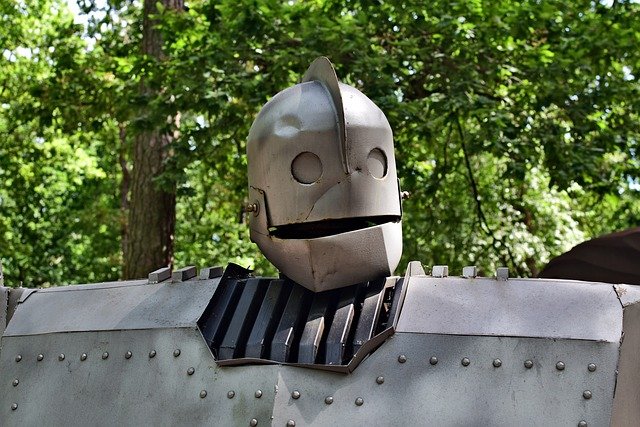In 2025, artificial intelligence (AI) is transforming robotics, enabling machines to think, act, and adapt like never before. By integrating AI technologies such as machine learning, computer vision, and natural language processing, robots are becoming smarter, safer, and more efficient across industries and homes. This article explores how AI is driving these advancements, making robotics a cornerstone of modern innovation.
Smarter Robots Through AI
AI empowers robots to process information, learn from experiences, and make decisions in real time, significantly enhancing their intelligence.
1. Advanced Perception with Computer Vision
AI-driven computer vision allows robots to interpret their environments with precision. In 2025, robots use high-resolution cameras and sensors to recognize objects, people, and patterns, even in dynamic or cluttered settings.
- Example: In warehouses, AI robots identify and sort packages with 98% accuracy, reducing errors in logistics.
- Impact: Robots can operate in unpredictable environments, such as homes or factories, with minimal human oversight.
2. Adaptive Learning and Autonomy
Machine learning enables robots to learn from data and improve over time. In 2025, reinforcement learning allows robots to adapt to new tasks without extensive reprogramming.
- Example: Domestic robots, like smart vacuums, map home layouts and optimize cleaning routes, avoiding obstacles like pets or furniture.
- Impact: Robots become more autonomous, reducing setup times and increasing productivity in industries like manufacturing and agriculture.
3. Natural Language Processing for Interaction
AI-powered natural language processing (NLP) allows robots to understand and respond to human commands. In 2025, robots interpret voice, text, and gestures for seamless interaction.
- Example: Retail robots answer customer queries, while surgical robots respond to doctors’ verbal instructions during procedures.
- Impact: Enhanced human-robot collaboration improves efficiency in service industries and healthcare.
Safer Robots with AI
AI is making robots safer by improving their ability to detect risks, avoid accidents, and protect sensitive data.
1. Collision Avoidance and Environmental Awareness
AI algorithms process data from LiDAR, sonar, and cameras to help robots navigate safely. In 2025, robots use real-time analysis to avoid obstacles and humans.
- Example: Autonomous delivery robots dodge pedestrians and traffic in urban areas, reducing collision risks by 90%.
- Fix: Edge AI, processing data on-device, ensures faster reaction times, enhancing safety in dynamic environments.
2. Predictive Maintenance
AI-driven predictive analytics monitor a robot’s health, identifying potential failures before they occur. In 2025, this reduces downtime and prevents accidents.
- Example: Industrial robots flag worn components, scheduling repairs to avoid malfunctions during critical operations.
- Fix: Integrate IoT sensors with AI to provide real-time diagnostics, ensuring continuous safe operation.
3. Enhanced Cybersecurity
As robots become more connected, AI strengthens their defenses against cyber threats. In 2025, AI detects anomalies and secures data transmission.
- Example: Home security robots use AI to identify hacking attempts, locking down systems to protect user privacy.
- Fix: Implement end-to-end encryption and regular firmware updates to safeguard connected robots.
More Efficient Robots Through AI
AI optimizes robotic performance, reducing energy use, streamlining tasks, and cutting costs.
1. Optimized Task Execution
AI enables robots to prioritize tasks and optimize workflows. In 2025, robots analyze data to find the most efficient methods for completing jobs.
- Example: In factories, AI robots reorganize assembly lines in real time, boosting output by 25%.
- Impact: Businesses save time and resources, improving profitability.
2. Energy Efficiency
AI algorithms optimize power consumption, extending battery life and reducing environmental impact. In 2025, robots adjust operations based on energy demands.
- Example: Agricultural robots use AI to schedule tasks during low-energy periods, cutting power usage by 20%.
- Impact: Sustainable robotics supports eco-friendly practices in industries and homes.
3. Scalable Automation
AI makes robotic systems scalable, allowing businesses to expand operations without significant reinvestment. In 2025, cloud-based AI enables seamless integration of new robots.
- Example: Logistics companies add AI robots to fleets, syncing them with existing systems via cloud platforms.
- Impact: Scalability reduces costs for small businesses adopting robotics.
Real-World Applications in 2025
- Manufacturing: AI robots handle precision tasks, reducing errors and increasing production rates by 30%.
- Healthcare: AI-powered surgical robots improve precision, leading to 15% better patient outcomes.
- Home Security: AI-driven cameras and drones detect threats with 95% accuracy, enhancing homeowner safety.
- Agriculture: AI robots monitor crops and optimize irrigation, boosting yields by 20% while conserving water.
Challenges and Solutions
Despite its benefits, AI in robotics faces hurdles:
- High Costs: Advanced AI systems can be expensive. Solution: Use modular designs and cloud-based AI to lower costs.
- Ethical Concerns: Autonomous robots raise accountability issues. Solution: Develop clear regulatory frameworks and transparent AI decision-making.
- Data Privacy: Connected robots risk data breaches. Solution: Employ AI-driven threat detection and robust encryption.
Why AI-Driven Robotics Matters in 2025
AI is making robots smarter, safer, and more efficient, unlocking new possibilities across industries. From reducing workplace accidents to enhancing home security, these advancements improve quality of life and drive economic growth. In 2025, the integration of 5G and edge AI further accelerates robotic performance, making them indispensable in a connected world.
Conclusion
In 2025, AI is revolutionizing robotics by enhancing intelligence, safety, and efficiency. Smarter robots adapt to complex tasks, safer systems protect users and data, and efficient designs optimize resources. By addressing challenges like cost and ethics, businesses and homeowners can fully leverage AI-powered robotics to create a more secure and productive future.
